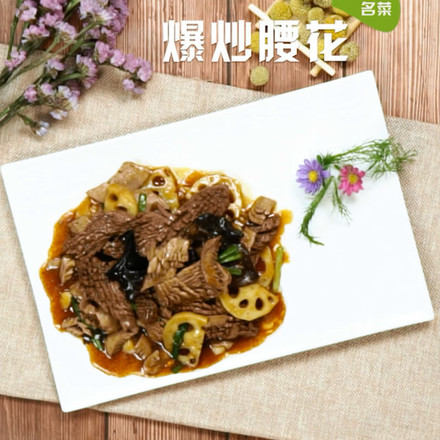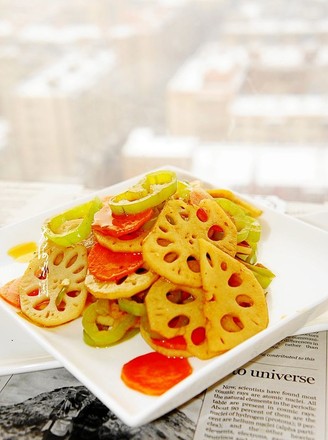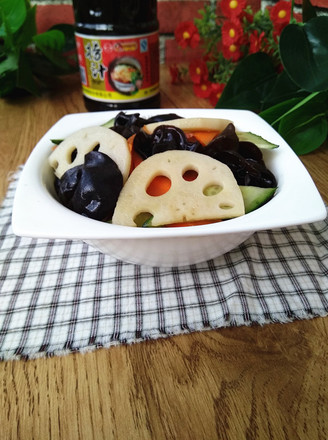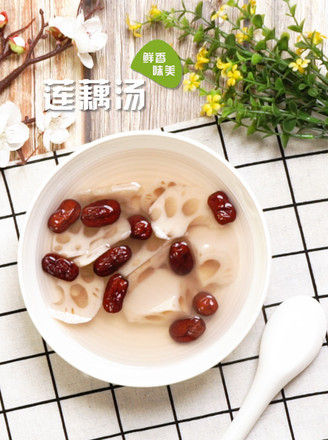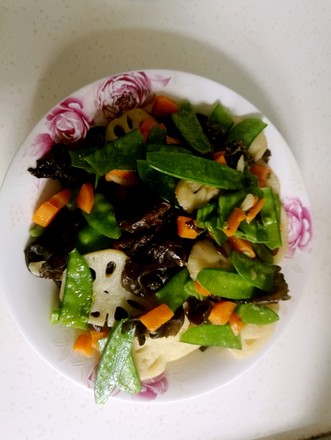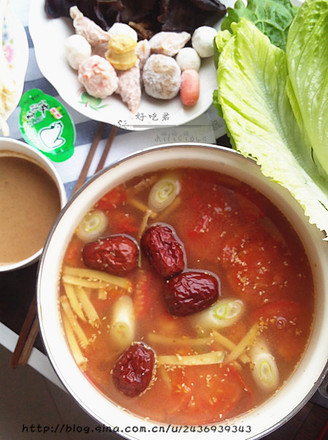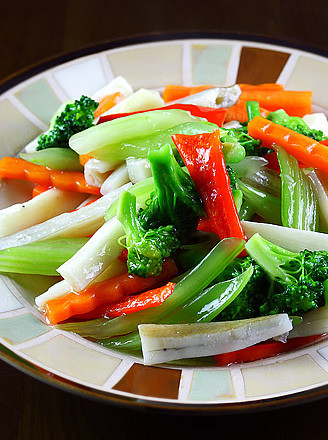Foods You Should Eat More in Autumn [lotus Root]~cold Lotus Root Slices
by Azalea Gourmet
Favorite
Difficulty
Easy
Time
10m
Serving
2
Why should we eat lotus root more in autumn?
People often say: Lotus is a treasure, autumn lotus root is the most tonic. The weather becomes dry in autumn, so foods that nourish yin and clear heat, moisturize dryness and quench thirst, and soothe the mind should be the main food. Lotus root is one of the best nourishing products in season. After the beginning of autumn, fresh lotus root has become a common dish on people's tables.
There are three types of lotus roots: safflower lotus root, white lotus root and twist lotus root. Safflower lotus root is long and thin, with brownish-yellow skin, rough, rich in starch, less water, glutinous but not crispy, good for soup; white lotus root is fat, tender and smooth in appearance, silvery white, tender and juicy in texture, The sweetness is strong, raw food is good; the twisted lotus root is pink, rough in appearance, and rich in starch.
Fresh lotus root is rich in calcium, phosphorus, iron and many vitamins. Among tuber foods, lotus root contains high iron content, so it is quite suitable for patients with iron deficiency anemia. This is the principle of using lotus root supplemented with other ingredients to boil the soup to replenish blood. The sugar content of lotus root is not very high, but also contains high vitamin C and dietary fiber. It is very beneficial for people with liver disease, constipation, diabetes and other debilitating diseases. The lotus root is rich in vitamin K and has hemostatic effect. It is very suitable for people with congestion, vomiting blood, jack blood, hematuria, hematochezia, and women who are pregnant.
The lotus root is eaten raw, which can clear away heat and moisturize the lungs, cool blood and promote stagnation. If the fresh lotus root is pressed to extract the juice, its effect is better. The ancients often mixed fresh lotus root juice, fresh pear juice, fresh Niemang juice, sugarcane juice, etc., to treat fever, thirst, yin damage, anxiety and other symptoms.
Ripe lotus root can invigorate the spleen and appetite, relieve diarrhea and consolidate essence. The elderly often eat lotus root, which can adjust the appetite, nourish blood and nourish the marrow, soothe the nerves and brain, and prolong life. Women can also eat lotus root after childbirth. After childbirth, they should not eat raw and cold, but lotus root is the only thing to avoid, because it has the properties of hemostasis and eliminates stasis. In addition, lotus root has the effect of clearing the lungs and stopping bleeding, and it is also very good for patients with tuberculosis.
When buying, you should choose a yellow-brown skin, thick and white flesh, and pay attention to no damage, no rotten, no rust spots, constant knots and no shrinkage or discoloration. The smaller the "parrot head" at the top, the better. If the lotus root is black and has a peculiar smell, it is not suitable for consumption.
Do not use cast iron pans when processing fresh lotus roots to prevent the fresh lotus roots from discoloring. In order to prevent the peeled lotus root from turning brown, the peeled lotus root can be soaked in dilute vinegar water for 5 minutes and then picked up and dried to keep the jade white, tender, and colorless. When frying lotus root silk, the lotus root usually turns black. If you add some water while frying, the fried lotus root silk will be as white as jade.
When we usually eat lotus root, we often discard the lotus root joints. In fact, the lotus root joints are a very good hemostatic medicine. Because it contains about 2% ravages and aspartic acid, its hemostatic and astringent effect is stronger than that of fresh lotus root. After mashing the lotus root joints, adding appropriate amount of brown sugar and decoction, it has a certain effect on various bleeding such as vomiting, hemoptysis, hematuria, hematochezia, and uterine bleeding.
It is worth noting that some people should not eat lotus root raw, because the fresh lotus root is cool, it is harder to digest raw lotus root and hurts the spleen and stomach. Therefore, people with spleen deficiency and stomach cold, and those who are prone to diarrhea, should eat cooked lotus root. It is more appropriate for parturients to eat lotus root after 1-2 weeks. "
People often say: Lotus is a treasure, autumn lotus root is the most tonic. The weather becomes dry in autumn, so foods that nourish yin and clear heat, moisturize dryness and quench thirst, and soothe the mind should be the main food. Lotus root is one of the best nourishing products in season. After the beginning of autumn, fresh lotus root has become a common dish on people's tables.
There are three types of lotus roots: safflower lotus root, white lotus root and twist lotus root. Safflower lotus root is long and thin, with brownish-yellow skin, rough, rich in starch, less water, glutinous but not crispy, good for soup; white lotus root is fat, tender and smooth in appearance, silvery white, tender and juicy in texture, The sweetness is strong, raw food is good; the twisted lotus root is pink, rough in appearance, and rich in starch.
Fresh lotus root is rich in calcium, phosphorus, iron and many vitamins. Among tuber foods, lotus root contains high iron content, so it is quite suitable for patients with iron deficiency anemia. This is the principle of using lotus root supplemented with other ingredients to boil the soup to replenish blood. The sugar content of lotus root is not very high, but also contains high vitamin C and dietary fiber. It is very beneficial for people with liver disease, constipation, diabetes and other debilitating diseases. The lotus root is rich in vitamin K and has hemostatic effect. It is very suitable for people with congestion, vomiting blood, jack blood, hematuria, hematochezia, and women who are pregnant.
The lotus root is eaten raw, which can clear away heat and moisturize the lungs, cool blood and promote stagnation. If the fresh lotus root is pressed to extract the juice, its effect is better. The ancients often mixed fresh lotus root juice, fresh pear juice, fresh Niemang juice, sugarcane juice, etc., to treat fever, thirst, yin damage, anxiety and other symptoms.
Ripe lotus root can invigorate the spleen and appetite, relieve diarrhea and consolidate essence. The elderly often eat lotus root, which can adjust the appetite, nourish blood and nourish the marrow, soothe the nerves and brain, and prolong life. Women can also eat lotus root after childbirth. After childbirth, they should not eat raw and cold, but lotus root is the only thing to avoid, because it has the properties of hemostasis and eliminates stasis. In addition, lotus root has the effect of clearing the lungs and stopping bleeding, and it is also very good for patients with tuberculosis.
When buying, you should choose a yellow-brown skin, thick and white flesh, and pay attention to no damage, no rotten, no rust spots, constant knots and no shrinkage or discoloration. The smaller the "parrot head" at the top, the better. If the lotus root is black and has a peculiar smell, it is not suitable for consumption.
Do not use cast iron pans when processing fresh lotus roots to prevent the fresh lotus roots from discoloring. In order to prevent the peeled lotus root from turning brown, the peeled lotus root can be soaked in dilute vinegar water for 5 minutes and then picked up and dried to keep the jade white, tender, and colorless. When frying lotus root silk, the lotus root usually turns black. If you add some water while frying, the fried lotus root silk will be as white as jade.
When we usually eat lotus root, we often discard the lotus root joints. In fact, the lotus root joints are a very good hemostatic medicine. Because it contains about 2% ravages and aspartic acid, its hemostatic and astringent effect is stronger than that of fresh lotus root. After mashing the lotus root joints, adding appropriate amount of brown sugar and decoction, it has a certain effect on various bleeding such as vomiting, hemoptysis, hematuria, hematochezia, and uterine bleeding.
It is worth noting that some people should not eat lotus root raw, because the fresh lotus root is cool, it is harder to digest raw lotus root and hurts the spleen and stomach. Therefore, people with spleen deficiency and stomach cold, and those who are prone to diarrhea, should eat cooked lotus root. It is more appropriate for parturients to eat lotus root after 1-2 weeks. "

![Foods You Should Eat More in Autumn [lotus Root]~cold Lotus Root Slices Foods You Should Eat More in Autumn [lotus Root]~cold Lotus Root Slices](https://img.simplechinesefood.com/ae/aeb8c459584dbf90f8924e1386725734.jpg)
![Foods You Should Eat More in Autumn [lotus Root]~cold Lotus Root Slices recipe Foods You Should Eat More in Autumn [lotus Root]~cold Lotus Root Slices recipe](https://img.simplechinesefood.com/be/be0955e8648f87d613c5e8e217c73ea6.jpg)
![Foods You Should Eat More in Autumn [lotus Root]~cold Lotus Root Slices recipe Foods You Should Eat More in Autumn [lotus Root]~cold Lotus Root Slices recipe](https://img.simplechinesefood.com/4a/4a095e944c5fb876f7dbdee9365754c7.jpg)
![Foods You Should Eat More in Autumn [lotus Root]~cold Lotus Root Slices recipe Foods You Should Eat More in Autumn [lotus Root]~cold Lotus Root Slices recipe](https://img.simplechinesefood.com/5c/5cd42b4e89b0f6ea8e1a01f957cd4e2f.jpg)
![Foods You Should Eat More in Autumn [lotus Root]~cold Lotus Root Slices recipe Foods You Should Eat More in Autumn [lotus Root]~cold Lotus Root Slices recipe](https://img.simplechinesefood.com/18/18261343f3af55d497b4dd165bdd3da8.jpg)
![Foods You Should Eat More in Autumn [lotus Root]~cold Lotus Root Slices recipe Foods You Should Eat More in Autumn [lotus Root]~cold Lotus Root Slices recipe](https://img.simplechinesefood.com/1b/1b0e77129bb00671950e5d6b2af59a26.jpg)
![Foods You Should Eat More in Autumn [lotus Root]~cold Lotus Root Slices recipe Foods You Should Eat More in Autumn [lotus Root]~cold Lotus Root Slices recipe](https://img.simplechinesefood.com/51/51dec21f6aac6e7684330b986cb48154.jpg)
